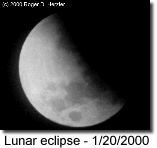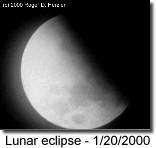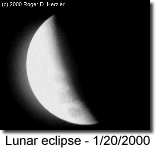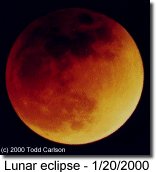|
Total
Lunar Eclipse - 01/20/2000
|
|
The total lunar eclipse
On Thursday night, January 20th, 2000 our planet Earth's shadow crossed across the Moon producing a total lunar eclipse.
What happened?
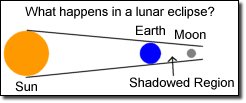 A
lunar eclipse, either partial or full, is the result of the Moon passing
through the Earth's Sun-produced shadow. As you can see in the diagram,
light from the Sun produces a shadow into which the Moon sometimes
crosses. The shadow is always there, but the Moon is there only in
rare instances such as this. The following table was applicable to
this event and lists the times of the major milestones that occurred:
A
lunar eclipse, either partial or full, is the result of the Moon passing
through the Earth's Sun-produced shadow. As you can see in the diagram,
light from the Sun produces a shadow into which the Moon sometimes
crosses. The shadow is always there, but the Moon is there only in
rare instances such as this. The following table was applicable to
this event and lists the times of the major milestones that occurred:
| Total Lunar Eclipse Milestones for January 20, 2000 | |||
| Milestone Event | GMT | EST | PST |
| Partial Eclipse Begins: | 03:01 AM* | 10:01 PM | 07:01 PM |
| Total Eclipse Begins: | 04:05 AM* | 11:05 PM | 08:05 PM |
| Mid-Eclipse: | 04:44 AM* | 11:44 PM | 08:44 PM |
| Total Eclipse Ends: | 05:22 AM* | 12:22 AM* | 09:22 PM |
| Partial Eclipse Ends: | 06:25 AM* | 01:25 AM* | 10:25 PM |
|
* Event occurs on morning of January 21, 2000 GST -
Greenwich Mean Time |
|||
My experience...
It was cloudy for the majority of the day. Frankly, I didn't think I'd get to see any of this one, but thankfully it cleared up a bit as the time got closer. There was almost always a thin haze in front of the Moon however. I got a late start on the event. I could see the shadow begining to creep across the Moon from the living room window before I had even finished dinner, but since I was only going to the driveway I knew that I could get things set up properly in short order. I went ahead and got loaded up and ready around 7:17pm. I was able to begin generating images by 7:21pm. Right around 7:50pm the clouds rolled in and the rest of the event was covered. I never made it to totality. Many thanks to Todd Carlson for filling in the photos with an exceptionally good totality photo!
Photographing Techniques
The equipment used included:
- Camera: Nikon FM2N
- Telescope: Celestron C4.5, diameter 114mm, f/l=900mm
- Film: 200 ASA Kodak Royal Gold
- Eyepiece: 20mm Kellner
- Method: Eyepiece Projection through a Meade Tele-extender and camera T-Mount adapter
The details for the above photos are in order of presentation from top to bottom:
| Image Number | Time (PST) | Exposure Length |
|
7:21pm
|
1/30th
second
|
|
|
7:23pm
|
1/8th
second
|
|
|
7:40pm
|
1/2
second
|
Image #4 from Todd was a 15 second exposure done on Fuji 400 ASA film through a 5" f/10 SCT telescope at 11:45pm local time in Toronto, Canada.
Although it might appear that exposures #1 and #2 are reversed in their times because one is brighter than another the illusion is actually a result of a longer exposure time in #2 than in #1. That made the Moon look more full than it should have. I made a complete log of every photo in a lab notebook. That came in handy after the fact to review what exposures worked and what didn't.
For this event I used a technique called "eyepiece projection". The variant on the method used in my tutorial is that I was able to make use of new piece of equipment in my bag - a camera adapter and tele-extender that actually holds an eyepiece right up to the film plane and inserts into the focusing tube easily. There are no lenses used on the camera. Instead, the tele-extender is attached to the camera via a T-mount. This method was very exciting and I'll have to expand more on it later. I feel that it can really free my lunar imaging skills up to make some better photos.
I didn't use the camera's meter very much due to the fact that the black background would overwhelm it's measurements and produce an errant recommendation. I chose to bracket above and below recommended shutter speeds. Since I didn't use a camera lens, as this was straight eyepiece projection through the tele-extender, I didn't have control of the aperture. The only exposure control I had was through shutter speed. The most common shutter speeds were around 1/30 and 1/60. Occasionally I pushed it to 1/125 and 1/15, but I didn't try that much.
What I'd do differently...
- Travel! People south of my area reported that they had clear skies for the entire event.
- Try to get a hold of a brighter focusing screen. A lot of the photos didn't come out very clear and I'm left to wonder whether or not it was focusing that might have contributed to it.
Other eclipse sites I'd recommend:
Todd Carlson's Simple Astrophotography Eclipse Photos

